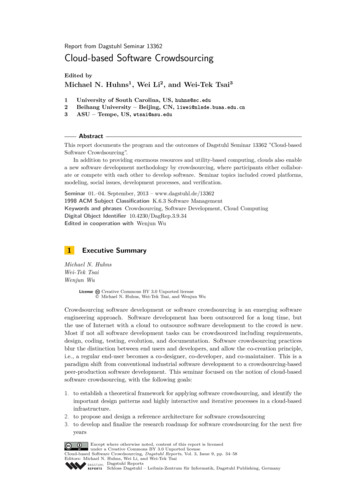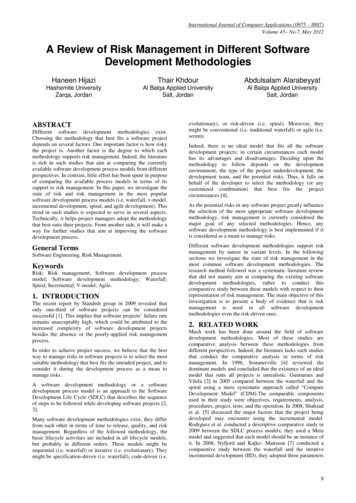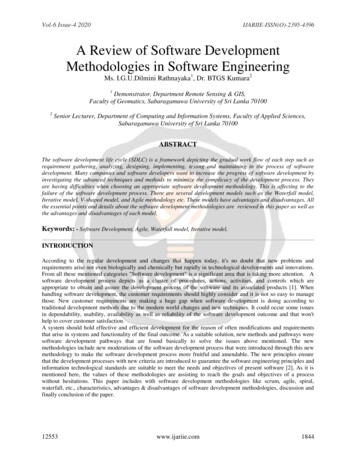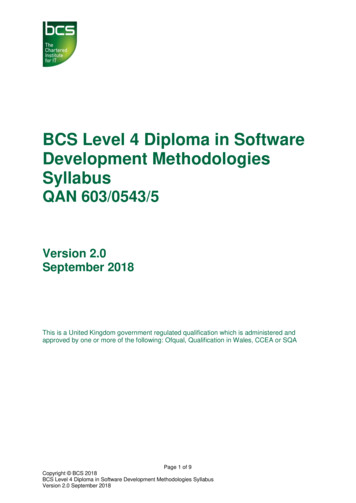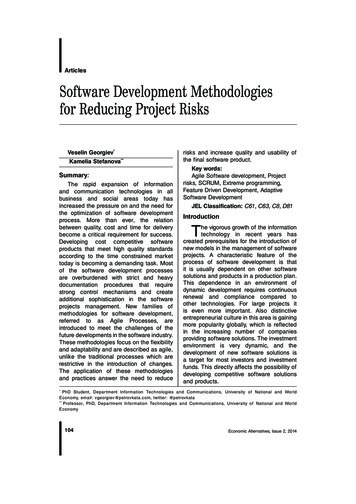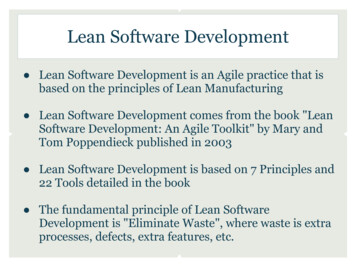
Transcription
Supporting Software Development throughDeclaratively Codified Programming Patterns Kim Mens a,1, Isabel Michiels a, , Roel Wuyts ba ProgrammingTechnology Lab, Vrije Universiteit BrusselPleinlaan 2, B-1050 Brussel, Belgiumb SoftwareComposition Group, Institut für Informatik, Universität BernNeubrückstrasse 10, CH-3012 Bern, SwitzerlandPreprint submitted to Expert Systems with Applications6 August 2001
AbstractIn current-day software development, programmers often use programming patterns to clarify their intents and to increase the understandability of their programs. Unfortunately, mostsoftware development environments do not adequately support the declaration and use ofsuch patterns. To explicitly codify these patterns, we adopt a declarative meta programmingapproach. In this approach, we reify the structure of an (object-oriented) program in termsof logic clauses. We declare programming patterns as logic rules on top of these clauses.By querying the logic system, these rules allow us to check, enforce and search for occurrences of certain patterns in the software. As such, the programming patterns become anactive part of the software development and maintenance environment.Key words: programming patterns, logic programming, meta programming, tool support,object-oriented programming1 IntroductionContemporary software development practice regards software construction as anincremental and continuous process that involves large development teams. In sucha context, it is crucial that the software is as readable as possible. One cannot afford Expanded version of a paper presented at the Software Engineering and Knowledge Engineering conference (Buenos Aires, June 2001). Corresponding author; fax: 32 2 629 35 25.Email addresses: Kim.Mens@vub.ac.be (Kim Mens),Isabel.Michiels@vub.ac.be (Isabel Michiels), wuyts@iam.unibe.ch (RoelWuyts).Kim Mens’ research was funded by the Brussels’ Capital Region (Belgium) and Getron-1ics.2
that programmers have to wade through piles of documentation and code to understand the software or to discover the intents of the original programmers. Instead,they should spend their precious time to tackle the real problem (that is, the taskof programming itself, i.e. conceptualizing, designing, implementing and maintenance (Teitelman, 1984)).Beck (1997) argues that by using commonly accepted programming patterns it becomes much easier for programmers to communicate their intents. Well-knownkinds of such patterns are best practice patterns (Beck, 1997), design patterns(Gamma et al., 1995), design heuristics (Riel, 1996), bad smells and refactoringpatterns (Fowler, 1999). A problem with these ad-hoc patterns, however, is thatthey are not supported by the programming language nor by the development environment. For example, whether or not a certain programming pattern is consistentlyused throughout a program solely depends on the programmers’ discipline and implicit conventions.By relieving the mind of all unnecessary work, a good notation sets it free to concentrate on more advanced problems, and in effect increases the mental powerof the race.Alfred North WhiteheadTo allow programmers to gain maximum profit from the extra information that isencoded in programming patterns, there is a need for tools that support the use ofsuch patterns. We envision the patterns as becoming an explicit and active part ofthe software development and maintenance environment. Some activities that suchan environment should support are: checking whether a piece of source code matches a certain pattern; finding all pieces of source code that match a pattern;3
searching for all occurrences of a given pattern that were used to program a pieceof source code; detecting violations of the usage of a pattern; enforcing the consistent use of some pattern throughout a program; generating code that matches a certain pattern.In this paper, we propose to use a declarative meta language for expressing andreasoning about programming patterns in object-oriented programs.2 Declarative Meta ProgrammingDeclarative meta programming (DMP) is an instance of hybrid language symbiosis, merging a declarative language at meta level with a standard (object-oriented)base language. Base-level programs are expressed in terms of logic facts and rulesat the meta level. Programming patterns are expressed as logic rules that reasonabout the logic clauses representing those base-level programs. By querying thelogic system, the rules can be used to check, detect, search for occurrences of andeven generate code fragments from programming patterns. Before discussing whatthe programming pattern rules look like, in this section we elaborate on the baseand meta language.As declarative meta language we use a Prolog variant. Logic programming haslong been identified as very suited to meta programming and language processingin general. Prolog’s expressive power (e.g. unification and backtracking) and itscapacity to support multi-way reasoning 2 are particularly attractive to reason about2A prototypical example is the append/3 predicate, which can be used to append two lists,check whether a list is the concatenation of two others, check for or generate prefixes and4
patterns.Although DMP can be applied to programs written in any programming language,in this paper we take the object-oriented language Smalltalk as base language. Onereason for choosing Smalltalk for our experiments is that there exists a “Smalltalkculture” (Fraser et al., 1996) which makes that Smalltalk programmers use a lot ofwell-known programming patterns to express important intents (Beck, 1997), butfor which no explicit language constructs are available.2.1 SetupA DMP environment consists of four main elements. In a logic language, we declare programming patterns as logic meta programs that reason about programswritten in an (object-oriented) base language. The logic meta programs are storedin a logic repository. The base-level language constructs are stored in an implementation repository that can be accessed from within the logic language, by means ofa meta-level interface.For the experiments in this paper we use the logic language QSOUL, the successor of the logic language SOUL (Wuyts, 1998), to allow powerful logic reasoning about Smalltalk programs. QSOUL is implemented in Smalltalk and allowsQSOUL clauses to reason about Smalltalk source code by allowing the executionof user-defined Smalltalk code as part of the logic reasoning process (Wuyts andDucasse, 2001).postfixes of a list, and so on.5
2.2 The Representational MappingThe representational mapping defines the meta-level interface between the declarative meta language and the object-oriented base language. For each base-languageconstruct we want to reason about at meta level, there are logic facts and ruleswhich reify that construct at meta level. For example, we have a predicate class(?C)which states that ?C is a class that exists in the current Smalltalk image. (Below,we explain this predicate in more detail.)Table 1 lists some of the predicates that constitute the representational mapping.Because our logic language is dynamically typed, in this table we use the followingnaming convention to indicate the types of the arguments to a predicate: a variablenamed ?C represents a Smalltalk class, ?M a method parse tree, ?N a method name,?V an instance variable name, ?P the name of a Smalltalk method protocol, ?MC aSmalltalk meta class, ?Stats a list of Smalltalk statements and ?Args a list of namesof argument variables.At this point, to avoid any confusion on the intended semantics of the predicates inTable 1, we stress that these predicates are ordinary Prolog-like predicates that canbe used only to verify or search for information. For example, class(?C) can be usedto retrieve all classes in the Smalltalk image or, when ?C is bound to a value, tocheck whether a certain class exists in the Smalltalk image. In Section 4, however,we will explain how we can still use these predicates as building blocks to definepredicates for detecting violations of patterns, enforcing patterns or generating codefrom patterns.Reification of Smalltalk language constructs at meta level is achieved by usingQSOUL’s symbiosis with Smalltalk. More specifically, QSOUL contains a prim6
itive construct, called “Smalltalk term”, to access the Smalltalk image directly byexecuting a piece of Smalltalk code as part of a logic rule. “Smalltalk terms” aredenoted by square brackets [. . . ] that contain Smalltalk code. The actual semanticsof these Smalltalk terms depends on the position where they occur: as a predication, as a logic term, or inside a generate predicate. The QSOUL rules and queriesbelow 3 , which reify the notion of Smalltalk classes, illustrate each of these possibilities. Rules that reify other Smalltalk language constructs are defined in a similarway; see Mens (2000) and Wuyts (2001) for more examples.class(?C) ifatom(?C),[Smalltalk includesKey: ?C name].The above rule states what happens when the class predicate is called with a constant value. In that case, the special Smalltalk term [Smalltalk includesKey: ?C name]checks whether the value, bound to the logic variable ?C, indeed represents an existing class in the Smalltalk image. A Smalltalk term used in the position of apredication is required to return true or false. Also, all logic variables occurring inthis Smalltalk term are required to be bound upon its execution, as they will be substituted by their corresponding Smalltalk value prior to evaluation of the Smalltalkexpression.class(?C) ifvar(?C),generate(?C, [Smalltalk allClasses]).3In QSOUL, the keyword if separates the body from the head of a rule; queries are ruleswith an empty head; logic variables start with question marks; a comma denotes logicalconjunction; lists are delimited with and terms between square brackets representSmalltalk expressions that may contain (bound) logic variables.7
This second rule is applied when ?C is variable. In that case, a primitive generatepredicate is used to unify that variable (the first argument of the predicate) oneby one with each of the classes present in the Smalltalk image. This is done byexecuting the Smalltalk term which is provided as second argument to the generatepredicate. This Smalltalk term is required to return a collection of results, each ofwhich will be unified with the variable (one by one).Given these rules, the queryif class([Array])verifies whether Array is an existing class in the Smalltalk image, whereas thequeryif class(?C)subsequently unifies ?C with every class in the Smalltalk image. Note that a Smalltalkterm used in the position of a logic term (as in the first query) can return anySmalltalk object. A returned Smalltalk object is automatically wrapped so that itis considered as a constant by the logic language. This kind of usage of Smalltalkterms enables QSOUL to reason about existing Smalltalk objects.Another important part of the representational mapping is the representation ofSmalltalk methods. To facilitate reasoning about methods, a method is representedas a logic data-structure that corresponds to the method’s parse tree, rather than asa string containing the original Smalltalk source code. A method parse tree consistsof five parts: the method’s class, the name of the method, its argument list, a list oftemporary variables and a statement list. For example, the following method of theSmalltalk class Number8
odd"Answer whether the receiver is an odd number."ˆself even falsehas as logic method parse treemethod( [Number], [#odd],arguments( ), temporaries( ),statements( return(send(send(variable([#self]),[#even], ),[# ], variable([#false]) )) ))To access the different parts of such a method parse tree, the representational mapping contains a set of predefined predicates: methodName, methodArguments, methodStatements and so on (see Table 1).For more details on the symbiosis between QSOUL and Smalltalk and on the reification mechanism in particular, we refer to Wuyts (2001). In the next section, weshow how best practice patterns, design patterns and other programming patternscan be encoded in QSOUL.3 Codifying Programming PatternsEvery programming language has its set of patterns that experienced programmersfollow to produce more understandable code (Beck, 1997) (Coplien, 1992). Theyuse such patterns to make clear their intents and to improve the overall readabilityof the software. In this section, we illustrate some of these patterns and show howthey can be codified in a DMP medium.9
3.1 Best Practice PatternsBeck’s “Smalltalk best practice patterns” capture commonly accepted programming conventions for Smalltalk (Beck, 1997). They suggest how to choose clearnames for objects, instance variables and methods, how to communicate the programmer’s intents through code, how to write understandable methods, etc. Asconcrete examples we discuss the Getting Method and Constructor Method bestpractice patterns.3.1.1 Getting MethodOne way to make the distinction between state and behavior more transparent inan object-oriented language is by hiding every access to the state of an object bya message send. This is the motivation behind the idea of accessing methods. Anaccessing method is responsible for getting or setting the value of an instance variable. All references to an instance variable should be made by calling these methods. Methods that get the value of a variable are Getting Methods; methods thatset the value of a variable are Setting Methods. The Getting Method best practicepattern (Beck, 1997) states:Getting Method How do you provide access to an instance variable?Provide a method that returns the value of the variable. Give it the same name asthe variable.One possible DMP implementation for representing the structure of a Getting Methodis given below. It declares that the statement list of a Getting Method consists of asingle statement, which merely returns the value of the instance variable ?V:gettingMethodStats( return(variable(?V)) ,?V).10
Note that the above fact expresses only the simplest form of a Getting Method.Other forms of Getting Methods can be codified by adding similar facts or rules.E.g., a Getting Method that uses ‘lazy initialization’ has an extra statement to initialize the value of the variable the first time the variable is retrieved. Due to spacelimitations, we did not include these other forms here.To check whether a method ?M of a class ?C is a Getting Method for some instancevariable ?V, we verify that the class implements a method with the same name asthe instance variable and that this method has the required form, as specified by thegettingMethodStats predicate.gettingMethod(?C,?M,?V) (?M,?Stats).Logic rules that codify the Setting Method pattern are very similar. See Wuyts(2001) for more details.3.1.2 The Constructor MethodThe Constructor Method best practice pattern indicates how you best express thecreation of a class instance (Beck, 1997):The Constructor Method. How do you represent instance creation?Provide methods that create well-formed instances. Pass all required parametersto them. (Put Constructor Methods in a method protocol called “instance creation”.)11
The fact that all Constructor Methods are, by convention, put in the instance creation method protocol, makes it very easy to codify this pattern:constructorMethod(?C, ?M) ifmetaClass(?MC,?C),methodInProtocol(?MC, [#’instance creation’], ?M),returnType(?M, ?C).In Smalltalk, Constructor Methods are defined on meta classes. Hence, we verifythat the method ?M belongs to the ‘instance creation’ method protocol of the metaclass. As an extra consistency check, we verify that the Constructor Method returnsan instance of the correct type ?C, by using an auxiliary predicate returnType.This typing predicate returnType only ‘guesses’ the type because Smalltalk is dynamically typed. To infer the type of the expression that is returned by the method,we look at all messages that are sent to that expression (in the context where itoccurs). A class is a possible type for that expression if it understands all thesemessages (if not, a ‘message not understood’ error may occur at run-time).3.2 Design PatternsWhereas best practice patterns define programming conventions at the level of single classes, methods or instance variables, design patterns (Gamma et al., 1995)have a more global scope and focus on typical class collaborations. As with bestpractice patterns, we codify the structure 4 of design patterns as logic meta pro4Note that a design pattern captures more than only the structure of a class collaboration.It also has a motivation, intent, applicability, as well as relationships with other designpatterns. In this paper, however, we only focus on the structure of design patterns.12
grams that reason about the structure of a base-level program. As an illustration,we codify the Visitor design pattern structure.The general idea of the Visitor design pattern is to separate the structure of someelements from the operations that can be applied on these elements. This separationmakes it easier and more cost-effective to add new operations, because the classesthat describe the element structure do not need to be changed. Separating the nodesof a parse tree from the different operations performed on those nodes (such as generating code, pretty printing, optimizing) is the typical example where the Visitordesign pattern offers a solution.As shown in Figure 1, in the Visitor design pattern structure there is a hierarchydescribing the elements and there is a separate hierarchy implementing the operations. Assume that Element is the root class of a hierarchy on which the subclassesof the class Visitor define operations. Every Element class defines a method acceptthat takes a Visitor as argument and calls this visitor. This call is in general uniquefor that element. The Visitor hierarchy consists of the classes that define operationson the Element classes. They just need to implement the calls made by the differentelement classes.The rule describing the structure of the Visitor design pattern is fairly straightforward. First of all, it declares that ?Visitor is a class that implements the visit method?VisitSelector. In the same way, the class ?Element implements a method ?M called?Accept. This method is responsible for calling a concrete visitor ?ConcreteVisitorwith the actual visit operation ?VisitSelector. Finally we verify that one of the arguments of this call is the receiver (denoted by self in Smalltalk) and that the passedvisitor ?ConcreteVisitor is an argument of the accept ector) if13
ments(?M, Args)) ccArgs).3.3 Other Programming PatternsNext to best practice patterns and design patterns, other patterns exist that checkwhether or not the software is well designed or well structured. Examples are Riel’sdesign heuristics (Riel, 1996) and Beck and Fowler’s bad smells (Fowler, 1999).As a typical example consider the following heuristic (Riel, 1996, Heuristics 5.6and 5.7):All abstract classes must be base classes and all base classes should be abstractclasses.This heuristic can be codified as follows:abstractClassHeuristic() aseClass(?C),abstractClass(?C)).where baseClass(?C) checks whether ?C is a class from which another class inheritsand abstractClass(?C) checks whether ?C is abstract by verifying that it containsat least one abstract method. In Smalltalk, abstract methods can be recognizedbecause they make a subclassResponsibility self send. In other words, we check14
whether their statement list matches the following pattern: bility’], ) A second example of a programming pattern for detecting ill-designed code is theDuplicated Code bad smell (Fowler, 1999):Duplicated Code. . . A common duplication problem is when you have the same expression in twosibling subclasses. . . .This ‘bad smell’, together with its proposed solution, is similar to Riel’s heuristic 5.10 (Riel, 1996), which suggests when and how to refactor two classes thatimplement the same state and behavior:If two or more classes have common data and behavior (i.e. methods) then thoseclasses should each inherit from a common base class which captures those dataand methods.Below, we codify two rules that check for a common expression in two classes. Tosave space we only show the easiest case where two classes ?C1 and ?C2 are declared to have common behavior if they implement a method with the same methodbody.commonBehavior(?C1,?C2,?M1,?M2) (?M1,?Stats),methodStatements(?M2,?Stats).Having common data is codified as having a common instance variable ?V of thesame type.15
commonData(?C1,?C2,?V) ?V,?Type),instVarType(?C2,?V,?Type).Similar to the returnType predicate, our lightweight type inference rules guess thetype of an instance variable by looking at all messages sent to that variable (in thescope of its class) and computing all classes that understand all these messages.In addition, initialization of variables, as well as factory methods and getting andsetting methods are taken into account.4 Supporting Software DevelopmentIn the previous section we used DMP to declare many kinds of programming patterns. In this section we explain how a programmer can use these rules to supporthim or her when developing or maintaining software. First of all, the rules can beused straightforwardly to check whether a certain pattern is satisfied or to searchfor source code that matches some pattern (4.1). But we can also use the same rulesas building blocks for rules that support detecting violations of patterns (4.2) andeven code generation (4.3). Finally, the rules can be used to enforce the consistentuse of a certain pattern, but as we will see in Section 5, this is essentially a toolissue.16
4.1 Checking and SearchingDue to the multi-way reasoning capability of our logic language, most predicatescan be used in multiple ways. To illustrate this, let us elaborate on the gettingMethodpredicate of Subsection 3.1.1. When calling the predicate with constant arguments,it merely checks whether a given method of a given class is a Getting Method for agiven instance variable. When the query contains variables, we search for all valuesthat satisfy the pattern. For example,if gettingMethod([Point],?M,[#’x’])returns the Getting Method for the variable ‘x’ of the Smalltalk class Point. We caneven use more than one logic variable, as inif gettingMethod([Point],?M,?V)which finds all Getting Methods ?M together with their corresponding instance variable ?V for the class Point.We can also use the predicate in the opposite way to find all classes that have aGetting Method for a given instance variable ‘name’:if gettingMethod(?C,?M,[#’name’])Again, this query returns several results (one for each of the classes that implementssuch a Getting Method).Finally, we can call the predicate with logic variables only, in which case all classesin the entire Smalltalk image are searched for Getting Methods. Computing such aquery may take a very long time, however.A similar reasoning can be made for all other predicates that were defined in Section17
3. As a second example of “checking and searching” we revisit the commonBehavior rule of Subsection 3.3 that tells us when to move common behavior in siblingsubclasses to their common base class. We can use the rule below to find all classes?C1 and ?C2 that should be refactored, or to detect whether two classes have somebehavior in common, and so on. (The third argument of the rule represents thecommon base class and the fourth and fifth argument are the methods to be moved.behaviorRefactoring(?C1,?C2,?Base,?M1,?M2) havior(?C1,?C2,?M1,?M2).A similar rule can be made for dataRefactoring.4.2 Detecting ViolationsDetecting violations of patterns differs from checking or searching for patterns inthe sense that we need to verify that a certain structure is not respected. Thus,detecting violations essentially comes down to checking the logic negation of thepredicates defined in Section 3.Getting MethodIn addition to checking whether a method is a Getting Methodand searching the image for occurrences of Getting Methods, we can also writequeries that check the source code for violations of the Getting Method pattern.Methods that violate the encapsulation imposed by the Getting Method programming pattern are methods that directly send messages to instance variables (withthe exception of Getting Methods themselves, because they are the only ones allowed to do so). The rule for detecting such violations verifies whether no method18
implemented in a class sends messages that have as receiver an instance variable ofthat class:accessingViolator(?C,?M,?V,?Msg) C,?M,?V)),isSendTo(?C,?M,variable(?V),?Msg).We can then invoke the query below to find all violations of the Getting Methodpattern. It returns the violating method ?M that directly accesses some instancevariable ?V, together with the class ?C it belongs to and the violating message ?Msgit sends to the instance variable.if accessingViolator(?C,?M,?V,?Msg)Visitor Design PatternAs an illustration of how to use the visitor predicate ofSubsection 3.2 for detecting violations, consider some class hierarchy with rootclass ParseTreeElement representing a parse tree. We want to detect all non-abstractparse tree elements that do not comply to the Visitor pattern. To do so, we select allsubclasses of ParseTreeElement that are not abstract, and for each of those we findthe ones that do not comply to the visitor �doNode:’],?VisSel))The last line in this query mentions the name of the visit-method (i.e., ‘doNode:’)used by the visitor to visit the nodes. When we do not know the name of thismethod, we use a variable. The system will then deduce the name used in a specific19
instance of the visitor pattern.The results of this query contain the methods that do not comply to the Visitordesign pattern, and that might need to be reimplemented. If the query fails, thismeans that all investigated classes and methods satisfy (the structure of) the Visitordesign pattern.4.3 Code GenerationTo generate code that adheres to a given pattern, the approach is somewhat different. We need special generation predicates that allow us to generate code forSmalltalk language entities, like methods, based on a complete structural description of those entities. Of course, the necessary precautions should be taken that theentity being generated does not already exist.Getting MethodInstead of searching for Getting Methods and violations thereof,it can be useful to generate automatically the code of the Getting Method for someinstance variable of a class. This can be done by combining the gettingMethodStatspredicate describing the body of a Getting Method with a low-level predicate generateMethod that uses of the strong symbiosis between QSOUL and Smalltalk togenerate the source code of a method from its logic parse tree description. We repeat that a method parse tree consists of five parts: the method’s class, the name ofthe method, its argument list, a list of temporary variables and a statement list.generateAccessorCode(?C,?V) ifinstVar(?C,?V),“Verify that no method with name ?V exists”not(classImplements(?C,?V)),20
“Construct the method body”gettingMethodStats(?Stats,?V),“Generate code from the parse tree description”generateMethod(method(?C,?V, , ,?Stats)).Note that, to build the actual structural description of the method to be generated,we use the predicates of the representational mapping (Table 1) to fill in the different parts of the method parse tree, rather than merely using them for checkingor searching the Smalltalk image. Again, the multi-way reasoning capabilities andthe powerful unification mechanism of our logic language prove quite handy here.The rule ends with a generateMethod statement to actually generate the code for themethod. Note that, when generating a method from its parse tree description, allparts have to be filled in. Due to space limitations, we will not show the detailedimplementation of the generateMethod predicate; see Wuyts (2001) for more details.Behavior refactoringAs a second example of code generation, we reconsiderthe predicate behaviorRefactoring of Subsection 4.1. It only searches the image forcommon methods to be refactored. To perform the actual refactoring, we codify thePull Up Method refactoring pattern (Fowler, 1999).Pull Up MethodYou have methods with identical results on subclasses.Move them to the superclass.Again we only show the easiest case where two methods have exactly the samebody (typically as a result of “copy and paste” programming). The rule below defines how to do the refactoring. The comments (between parentheses) explain the21
code; the mechanics of the refactoring corresponds to what is described by Fowler(1999).pullUpMethodCode(?C1,?C2) if“Check that ?C1 and ?C2 have common M2),“Retrieve information about the common s(?M1,?Temps),“Verify t
software development environments do not adequately support the declaration and use of such patterns. To explicitly codify these patterns, we adopt a declarative meta programming . To access the different parts of such a method parse tree, the representational map-ping contains a set of predefined predicates: methodName, methodArguments .




